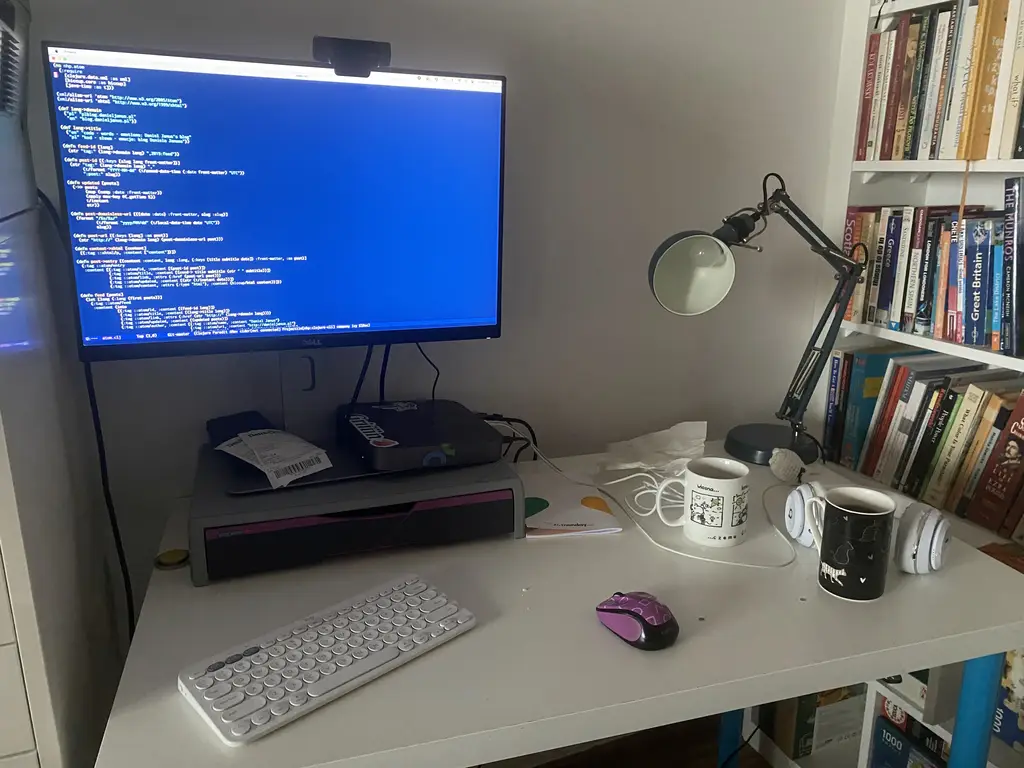Daniel Janus’s blog
No, really, you can’t branch Datomic from the past
(and what you can do instead)
22 April 2025
I have a love-hate relationship with Datomic. Datomic is a Clojure-based database based on a record of immutable facts; this post assumes a passing familiarity with it – if you haven’t yet, I highly recommend checking it out, it’s enlightening even if you end up not using it.
Cleaner codebase, happier mind
2 March 2025
This is my home-office desk on a typical day. Yuck – look at those mugs, cables and rubbish!

As a person with ADHD, I have a hard time maintaining cleanliness – and a high tolerance to mess around me. However, being in a cluttered environment does take its toll. Often I find myself frustrated by it, but also overwhelmed by tasks at hand, to the point of cleaning up feeling almost an insurmountable chore; often, when I start my workday by physically cleaning things up, I find it giving me a dopamine boost that impacts my productivity for the rest of the day.
Double, double toil and trouble
or, Corner-Cases of Comparing Clojure Numbers
21 February 2025
Let’s talk about Clojure.
In Clojure, comparing two numbers can throw an exception.

Check this out:
(< 1/4 0.5M)
;=> true ; as expected
(< 1/3 0.5M)
; Execution error (ArithmeticException) at java.math.BigDecimal/divide (BigDecimal.java:1783).
; Non-terminating decimal expansion; no exact representable decimal result.
Lossy CSS compression for fun and loss (or profit)
26 January 2024
What
Late last year, I had an idea that’s been steadily brewing in my head. I’ve found myself with some free time recently (it coincided with vacation, go figure), and I’ve hacked together some proof-of-concept code. Whether or not it is actually proving the concept I’m not sure, but the results are somewhat interesting, and I believe the idea is novel (I haven’t found any other implementation in the wild). So it’s at least worthy of a blog post.
My mental model of transducers
9 September 2023
Intro
I’ve been programming in Clojure for a long time, but I haven’t been using transducers much. I learned to mechanically transform (into [] (map f coll)) to (into [] (map f) coll) for a slight performance gain, but not much beyond that. Recently, however, I’ve found myself refactoring transducers-based code at work, which prompted me to get back to speed.
A visual tree iterator in Rust
20 July 2023
My adventure with learning Rust continues. As a quick recap from the previous post, I’m writing a tree viewer. I have now completed another major milestone, which is to rewrite the tree-printing function to use an iterator. (Rationale: it makes the code more reusable – I can, for instance, easily implement a tree-drawing view for Cursive with it.)
Learning to learn Rust
6 July 2023
I’m enjoying a two-month sabbatical this summer. It’s been great so far! I’ve used almost half of the time to cycle through the entire Great Britain and let my body work physically and my mind rest (usually, the opposite is true). And now that I’m back, I’ve switched focus to a few personal projects that I have really wanted to work on for a while but never found time.
Dutch Clojure Days 2022
7 November 2022
It’s a tradition of this blog that I write down impressions on my way back from Amsterdam conferences (addendum a week later: unfortunately I took a flight this time, too short to complete this entry, and it had to wait until I caught up). This time, it was Dutch Clojure Days 2022, my first post-COVID full-size conference and the first DCD I’ve ever been to. And, hopefully, not last. I know I want to come back.
How to pay for books
24 September 2022
This post was originally published in Polish. This translation has been slightly edited to explain some details that are likely to be obscure for people outside Poland.
Fortuna imperatrix mundi
I wouldn’t make a good emperor of the universe.
I love my GPD Micro PC
18 August 2022
I bought two computers this year: a beefy Macbook Pro with M1 Pro and a GPD Micro PC.
The MBP is meant to be my mobile workstation, to satisfy all my needs whenever I need to work outside of my home office (at home, I’m still mostly using a two-year-old Intel-based Mac Mini). The GPD was a caprice. Perhaps I’m at the stage in life when well-off men buy themselves Ferraris to fend off a mid-life crisis; or perhaps I just have a separate heart for small computers.